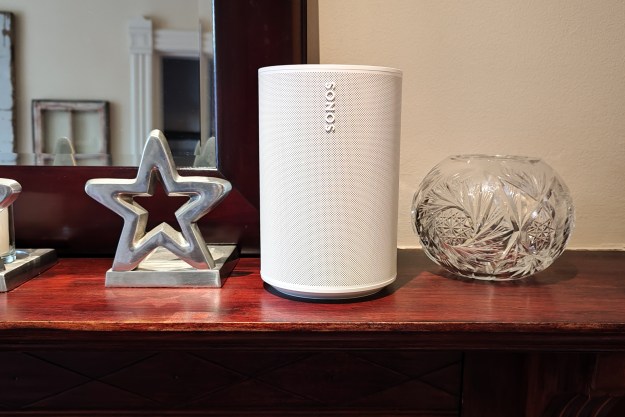
- Big, expansive sound
- Bluetooth now built-in
- Optional analog line-in
- Super-easy room tuning
- No Google Assistant option
The venerable Sonos One — the company’s most popular wireless speaker and the basis for many wireless home audio systems — is about to be no more. In its place, the new Era 100 ($249), a similar-looking speaker that has a lot more going on inside, including a much-requested Bluetooth connection and the ability to produce stereo sound.
Is the Era 100 a worthy successor to the One? Let’s dig in. And then be sure to check out our Sonos Era 300 review.
Familiar lines
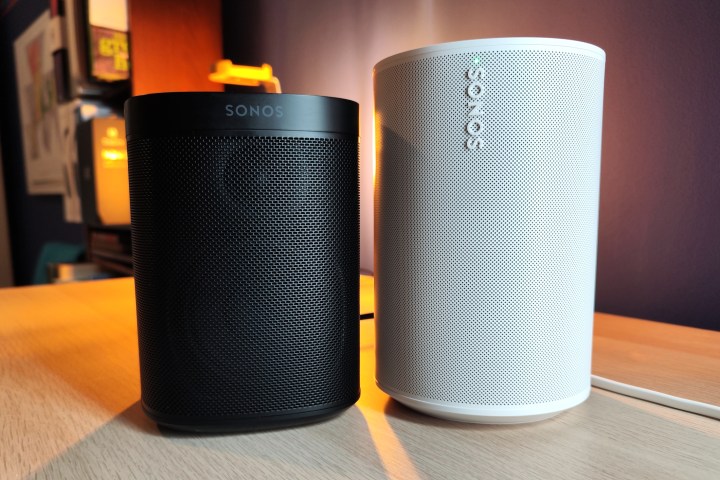
One of the best features of the Sonos One is its ability to produce great audio from a relatively small enclosure that can be tucked into a corner, or hidden in a bookshelf. It’s also found a home in a lot of kitchens where its voice assistants come in handy when you’re busy with food prep. The Era 100 mostly sticks to this successful formula.
It stands about an inch taller than the Sonos One and has a more cylindrical shape. But its overall footprint remains the same and lets it occupy all of the same spaces, so long as there’s still headroom.
If the Era 100 is your first Sonos speaker, I think you’ll unreservedly love it.
Sonos has been gradually evolving the look of its products away from materials like fabrics and metal in favor of an all-plastic construction, and this makes the Era 100 even more kitchen- and bathroom-friendly. Available in Sonos’ two standard color options — black or white — the finish has just the tiniest amount of sheen, making it smooth enough to wipe clean, while the plastic grille should be able to survive scratches and impacts better than the One’s metal grille.
Fans of the original Sonos Play:1 (the model before the Sonos One) will be happy to see that a standard quarter-inch threaded mounting hole makes a return on the Era 100 (the Sonos One and One SL lacked this element), opening the door to a variety of stand- and wall-mounting options that don’t require an unsightly clamp design. Sonos sells both of these accessories for the Era 100, starting at $69 for a single wall mount.
The matching power cord still plugs into the bottom and sits flush with the surface, but Sonos made the plug circular, with a deep groove, making it a little easier to remove.
Better controls
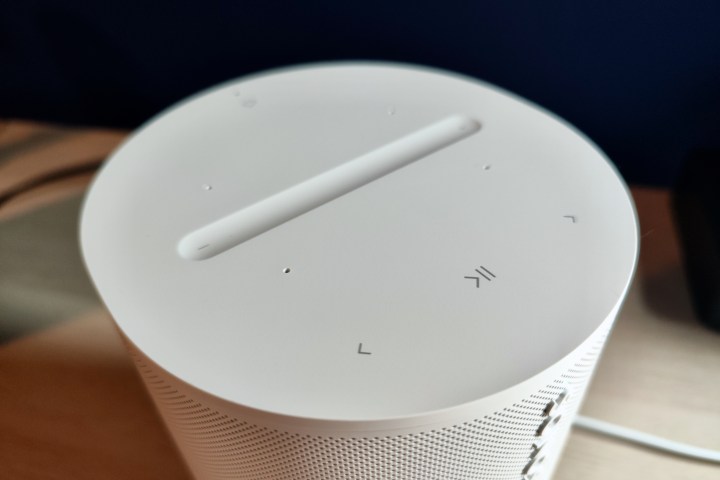
Touch controls can work well. But once you start to include gestures like swiping to the left or right, you might encounter problems. That was the case on the Sonos One, which required swipes over the volume controls to skip or repeat a track. Sometimes it worked, sometimes it didn’t — and sometimes it ended up changing the volume instead.
The Era 100’s reworked top control panel fixes this by making track and volume control totally separate. You can still bump the volume up and down one increment at a time by tapping on the plus and minus controls (or tap and hold), but there’s now a volume slider, too, which lets you drag a finger along a groove until you find the level you want.
It’s a nice addition that works well, but I wish Sonos had found a way to illuminate the controls. As on the Sonos One, the Era 100’s touch indicators can be hard to see when they’re not in direct light, and almost impossible to find in a dimly lit room.
Not quite as smart
Unfortunately, due to an ongoing dispute between Sonos and Google, the Era 100 doesn’t support Google Assistant for voice commands. This could be a temporary, or a longer-term situation as Sonos tries to maintain its platform-agnostic approach to voice assistants while at the same time continuing to develop its own in-house Sonos Voice Control (SVC) system.
So for now, the Era 100 can only be used to talk to Amazon Alexa and SVC, which should be kept in mind if you’re contemplating an upgrade from the Sonos One, which can access all three voice assistants.

On the literal bright side, there’s now a tiny LED light behind the grille just above the Sonos logo that gives you a visual confirmation when you say “Alexa,” or “Hey, Sonos.” That’s a major improvement over the Sonos One, which only had top-mounted feedback lights — impossible to see if you had the speaker placed anywhere higher than shoulder height.
The Era 100 keeps the One’s simple tap-to-mute microphone control. But for added privacy control there’s also a switch on the back of the speaker that lets you physically cut the mic array’s circuits. (Other smart speakers have done this, too.) Given that Sonos hasn’t announced any plans for mic-less “SL” variant of the Era 100, it’s a fair guess that the company believes this new privacy switch should be enough to calm the fears of those who don’t like it when their devices listen 24/7.
When in use, the microphone array does a good job of responding to voice commands as long as the Era 100 is the only source of music in the room. If you happen to have a different sound system going (like a kitchen TV) it can sometimes struggle. At the time of my review, Alexa wasn’t fully functional on the Era 100, but Sonos Voice Control worked without a hitch.
But way better connected
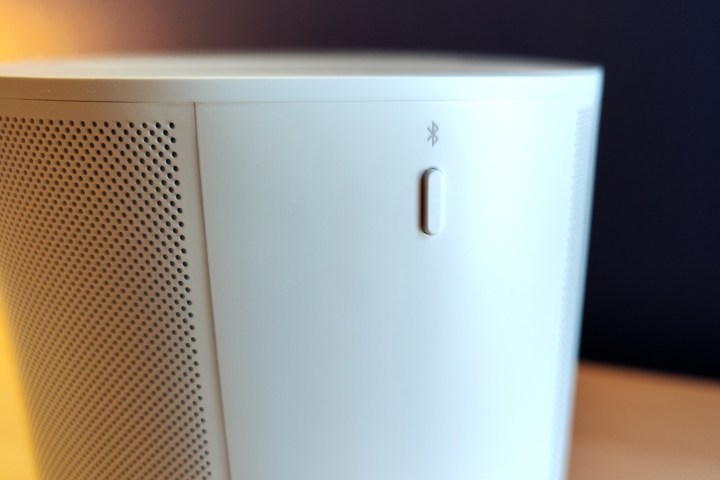
The Era 100 makes some pretty big strides in the sound department, which I’ll get to in a moment. But from a pragmatic point of view, the biggest change is Sonos’ long-awaited embrace of Bluetooth for wireless audio streaming and the ability to connect an external audio source.
Thankfully, Sonos didn’t just bolt Bluetooth onto the Era 100 the way it did with the Sonos Move. Using Bluetooth with that speaker disables Wi-Fi, leaving you unable to control the speaker with the Sonos app. The Era 100, by contrast, uses the same approach as the newer Sonos Roam. Enabling Bluetooth while you’re still within range of your Wi-Fi network lets any Bluetooth device connect to the speaker and start streaming audio while preserving the ability to control the speaker’s settings via the Sonos app.
You can finally connect a turntable to an affordable Sonos speaker.
Better yet, you can then group the Era with any (or all) other Sonos speakers in your home, and that Bluetooth stream will play through all of them simultaneously.
Using the feature couldn’t be easier. Simply long-press the Bluetooth button on the speaker’s back panel — a much better location than on the Roam — and wait for that front LED indicator to pulse blue, then look for the Era to appear in your phone’s Bluetooth devices menu.
If at any point you want to terminate that Bluetooth stream, you can do so within the Sonos app, use a voice command, or just press the Bluetooth button again.
You can also use the Era 100’s Bluetooth connection on its own, without Wi-Fi, but only after the initial set-up process (using Wi-Fi) is finished, so don’t expect it to act as a Bluetooth speaker right out of the box.
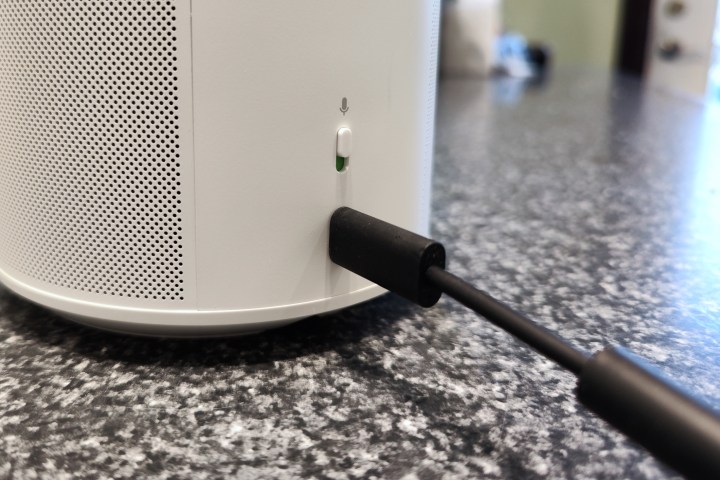
Despite the Era’s ability to do hi-res audio in up to 24-bit/48kHz over Wi-Fi, its Bluetooth skills are more pedestrian: only SBC and AAC Bluetooth codecs are supported. If you listen closely, you’ll hear a difference — Bluetooth streams don’t sound quite as detailed as their Sonos app equivalents, especially when listening to lossless audio tracks.
For those who want a higher-quality stream that’s not regulated by the Sonos app, you still have options: Spotify Connect, Tidal Connect, and AirPlay 2 (though that last one is only for Apple devices).
Keen observers will note that, unlike every previous Sonos home wireless speaker, there’s no Ethernet port on the back of the Era. In its place, a USB-C port now acts as a potential universal connector. At launch, you can choose between a 3.5mm line-in adapter ($19) for external music sources or a combo adapter that adds an Ethernet jack next to the line-in port ($39).
This is great news for vinyl fans — you can finally connect a turntable to a (relatively) affordable Sonos speaker. Previously your only choices were pricey ($449 Port, $549 Five) or very pricey ($699 Amp). You’ll still need a preamp to do so (and probably a stereo RCA-to-3.5mm patch cord), but once connected you can pick that line-in source from any Sonos speaker in your system — no need to group them with the Era 100 to hear the audio.
For now, Sonos is only offering an analog line-in adapter, but I’m holding out hope that a digital option will be available in the future.
Still so easy
If you’ve never set up a Sonos speaker, you’re in for one of the easiest procedures in the tech world. Once you’ve downloaded the Sonos app and created your account, simply plugging the Era 100 into a power outlet is all it takes to kick off a rapid, 2-minute-or-less set of steps that gets the speaker connected to Wi-Fi and ready to play.
If you’re adding the Era 100 to an existing Sonos system, it’s even faster. For a full rundown on everything a Sonos system can do, check out our in-depth Sonos explainer.
The Era 100 gets a new version of Sonos’ room-tuning Trueplay technology that leverages the speaker’s built-in mic to perform the calibration. This is the only method of Trueplay that’s available to Android users (the “advanced” version needs an iPhone). I was concerned that this “quick tuning” version would be less capable. But after trying both versions of Trueplay on the Era 100, I can’t say I could hear an appreciable difference, and the quick tuning process is much faster than advanced tuning.
Expansive sound

Enough about features. Let’s talk sound.
Sonos has proven once again that it can extract magical amounts of sound from a tiny speaker. This was true of the Sonos One, but with the Era 100, Sonos has pushed the boundaries even further. Thanks to its twin angled tweeters, it creates an impressive sense of openness. Compared to the Era 100’s airy and expansive soundstage, the Sonos One sounds narrow and a bit constrained. This makes the Era 100 an excellent single-speaker solution for most rooms.
Sonos has increased the size of the woofer on the Era 100. And as you might expect, that gives it a bigger, bolder bass response. Sonos speakers always have punched above their weight in the bass department, but what I noticed most was how much more melodic that bass can be with a speaker like the Era 100. Instead of delivering a formless thump, there’s real nuance to the low-end, which you can hear on tracks like Hans Zimmer’s Time and Warming Up My Instruments.
Out of the box, you may not find the bass quite as pronounced as it is on the Sonos One. But if you reach into the EQ settings, you’ll find that even a few increased notches on the bass slider make a huge difference.

If the Era 100 is your first Sonos speaker, I think you’ll love it, unreservedly. But for those who are already intimately familiar with the Sonos One, I have a few observations.
If you set these speakers side by side and sit directly in front of them, you may find the Era 100 sounds less precise in the higher frequencies, especially with vocals and acoustic performances like U2’s recently released Songs of Surrender album. I think that’s because the Era’s tweeters aren’t aimed directly at you, while the One’s single tweeter is aimed front and center.
At first, I wasn’t sure if I was OK with this difference. But the more I listened to the Era — and especially as I wandered around the room, listening from different locations — I began to really appreciate the way the Era distributes sound. It’s less directional, but in most situations that works in its favor.
Unfortunately, I was only able to test a single Era 100, so I can’t speak to its performance when set up as a stereo pair. But I did get a chance to do this with the new Era 300, and if that experience is any indication, I suspect a set of Era 100s will prove to be an amazing listen.

Consider the competition
A quick look at the competition: there are only three products that I think come close enough to the Sonos Era 100 to be worth serious consideration.
The Bluesound Pulse Flex 2i ($299) can go toe-to-toe with the Era 100 on connections like Wi-Fi, Bluetooth, AirPlay 2, and it even has a combo digital/analog input that doesn’t require a dongle. Plus it supports hi-res audio up to 24-bit/192kHz. However, it’s more expensive, it doesn’t offer any smart speaker functions, it doesn’t reproduce stereo, and the Bluesound app is still not as powerful or as easy to use as Sonos.
The Denon Home 150 Wireless Speaker ($249) matches the Era’s price, Bluetooth, AirPlay 2, and Alexa smart speaker capabilities, and like the Pulse Flex it can do hi-res and comes with a built-in analog input, and even has a USB port for music hard drives, but it’s also a mono speaker and the Denon HEOS app is considerably clunkier than the Sonos app.
Bose’s Smart Speaker 500 ($379) might just be the best of the three, with true stereo sound, your choice of Google Assistant or Amazon Alexa, Bluetooth, AirPlay 2, Chromecast, an analog input, and even a built-in color screen to display album art. But the Bose Music app is the weakest of the bunch, with very limited music service support. It’s also 50% more expensive than the Era 100.
I’ll also include Apple’s HomePod Gen 2, if for no reason other than, well, Apple. At $299 the HomePod is a bit more expensive, but it produces better sound than the Era 100, especially in the low end. It’s even compatible with Dolby Atmos Music. Where the HomePod falls short is in the details: no Bluetooth, no ability to line in other sources, no wall-mount options, extremely limited app support via the Apple Home app, and you only get one choice of voice assistant: Siri.
Even though Sonos has priced the Era 100 a bit higher than the Sonos One it replaces ($249 versus $219), there’s more than enough built into this speaker to justify the extra $30. With better, more immersive sound, available Bluetooth connections, Trueplay tuning that’s now super fast and works even if you’re on an Android device, and the ability to connect an external source like a turntable, the Era 100 is both an excellent first step into wireless home audio and a welcome addition to an existing Sonos system. The only caveat that may give you pause is its current lack of Google Assistant as an AI voice option.











